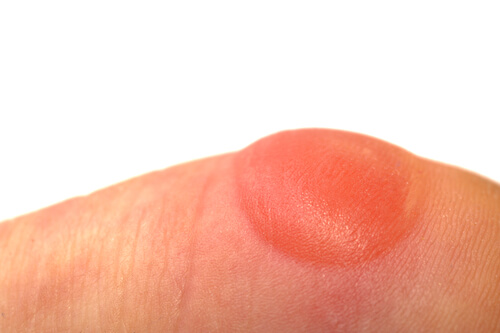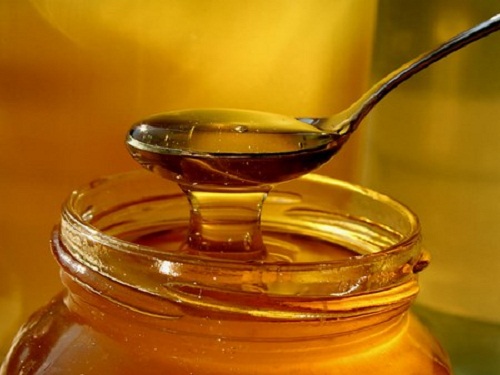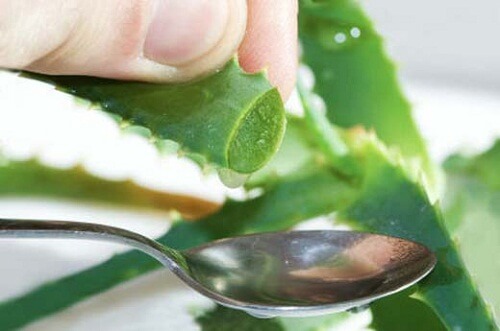Natural Treatments for Shingles

Varicella-zoster, also known as “shingles” is a disorder that originates from the varicella group of viruses. It lies “dormant” in the body and can “wake up” for a variety of reasons. Learn a little more about this disease as well as some natural treatments for shingles in this article.
Shingles: what to know
Having shingles is painful: it manifests as a rash of blisters filled with liquid. It’s particularly common for them to appear on the back and the stomach. This condition caused by the same virus that causes chickenpox, which lies dormant in your body’s nervous system your entire life.
Shingles occurs when the virus is reactivated, usually because the immune system is weakened by other diseases like cancer or HIV, an organ transplant, lack of vitamins and minerals, stress, or excessive anxiety.
This disease only affects people who have had chickenpox, which is a very common disease in children. It starts with a tingling sensation in the body and then erupts as a rash of liquid-filled blisters.

Also Read: Signs of Shingles
At-home and popular natural treatments for shingles
- Put a moist bandage on the rash as it’s growing. Soak a towel in cold water, wring it out, and leave it on the area for a few minutes until the towel warms to room temperature.
- Add a cup of oatmeal or cornstarch to bath water. Soak in the tub for about 20 minutes. Repeat every day before going to bed to relieve itching.
- Apply a little hydrogen peroxide to blisters that look infected using an eye dropper or a cotton ball.
- Apply pure honey or fresh leek juice to the rash every day to ease the sting.

- Boil 2 ounces of verbena flower in a cup of water for five minutes. Moisten a cloth with the liquid and place it over the affected area of the skin. Repeat each time until the cloth is dry.
- Put a few drops of tea tree oil on a cotton ball and gently swab the area affected by the rash.
- Mash two tablespoons of ripe banana in a cup of boiling water. Cover and let cool. Soak a cotton ball or cloth in the mixture and use it as a compress on the affected area.
- Boil a handful of burdock leaves in 16 ounces of water for five minutes. Remove from heat, allow it to cool, and soak a cotton cloth in the liquid. Apply it to the affected area and leave on for half an hour.
- Boil a handful of dandelion flowers in a liter of water for fifteen minutes. Drink three cups of this per day.

- Boil two handfuls of sorrel leaves in a liter of water for ten minutes. Remove from heat, let cool, and soak a cloth with this tea. Place the cloth on the rash.
- Mix half of a chopped carrot with boiling water to get a paste. Apply this to areas that are affected by the rash.
You Might Also Like:
Four Delicious Carrot Recipes
- Drink several cups of lemon balm tea a day for its antiviral properties. This helps keep the virus from spreading to other parts of the body. You can also store used tea bags in the refrigerator and apply them directly to the blisters.
- Make an ointment using hot pepper seeds and aloe vera gel (or buy a cream that contains these ingredients). You can also include hot peppers in your daily diet for their supply of capsaicin (which can also be purchased in lotion form from drug stores).

- Lemon balm is a powerful and effective plant that’s one of the most effective natural treatments for shingles. It has calming, analgesic, and antispasmodic properties. Make a tea using a good amount of this herb and let it cool so it won’t be too hot. Apply it to the affected area with a cotton ball or cloth, at least four times per day. Drinking the tea can also help fight associated discomfort (like fever or general pain).
- Another one of the natural treatments for shingles that’s highly recommended for shingles is Uncaria tomentosa, or “cat’s claw.” It’s a potent antiviral and anti-inflammatory agent, although it should not be used by women who are pregnant. Make a tea with the leaves and follow the same steps for using lemon balm, above.
Ways to prevent or treat varicella-zoster, or shingles
- Be sure to eat foods that are rich in vitamins B and C because they stimulate the immune and nervous systems.
- Avoid covering the blistered areas with warm fabrics like wool because it will only increase the pain and discomfort. Wear loose cotton clothing – synthetic fabrics can increase itchiness.
- Do not pop the blisters. This will only cause more discomfort and scars.
- Try to avoid people who have immune problems like young children, transplant patients, people who have HIV or cancer, because you could potentially pass the infection onto them.
- Try to relax and rid yourself of stress and anxiety using whatever techniques work for you – like yoga, meditation, self-hypnosis, or image visualization.
- Avoid sudden changes in temperature or air pressure because this can “send” signals to the nerves that activate the virus.
- Expose the affected area to sunlight for a few minutes. This can speed up healing by helping to “dry out” the rash.
We hope you’ve enjoyed this article on natural treatments for shingles!
All cited sources were thoroughly reviewed by our team to ensure their quality, reliability, currency, and validity. The bibliography of this article was considered reliable and of academic or scientific accuracy.
- Steiner, I., Kennedy, P. G., & Pachner, A. R. (2007). The neurotropic herpes viruses: herpes simplex and varicella-zoster. Lancet Neurology. https://doi.org/10.1016/S1474-4422(07)70267-3
- Weinberg, J. M. (2007). Herpes zoster: Epidemiology, natural history, and common complications. Journal of the American Academy of Dermatology. https://doi.org/10.1016/j.jaad.2007.08.046
- Kim, Y., Kim, H., Bae, S., Choi, J., Lim, S. Y., Lee, N., … Lee, W. J. (2013). Vitamin C Is an Essential Factor on the Anti-viral Immune Responses through the Production of Interferon-α/β at the Initial Stage of Influenza A Virus (H3N2) Infection. Immune Network. https://doi.org/10.4110/in.2013.13.2.70
- García-González AI, Rosas-Carrasco O. (2017). Herpes zoster (HZ) y neuralgia posherpética (NPH) en el adulto mayor: particularidades en la prevención, el diagnóstico y el tratamiento. Gac Med Mex., 153(1), 92-101.
- García Cenoz, M., Castilla, J., Montes, Y., Morán, J., Salaberri, A., Elía, F., Floristán, Y., Rodrigo, I., Irisarri, F., Arriazu, M., Zabala, A., & Barricarte, A.. (2008). Incidencia de la varicela y el herpes zóster antes de la introducción de la vacunación sistemática infantil en Navarra, 2005-2006. Anales del Sistema Sanitario de Navarra, 31(1), 71-80.
-
Brenes, N. (2016). Manejo de pacientes con herpes zoster. Rev Med Cos Cen, 73 (619), 255-260.
- España, A. (2009). Tratamiento del herpes zoster en pacientes inmunocompetentes e inmunodeprimidos. Seminarios de la Fundación Española de Reumatología, 10(1), 15-23.
- Carrillo-Rosario, T. & Díaz De Ramírez, A. (2006). Actividad antimalarica de extractos acuosos de Lantana camara L., Verbena littoralis L. y Heliotropium indicum L. en ratones infectados con Plasmodium berghei Revista de la Facultad de Farmacia, 48(1). http://www.saber.ula.ve/farmacia.
- Gómez Ugarte, M., Reyes Rojas S., & Paredes Choque L. (2015). La manzanilla y sus propiedades medicinales. Rev. Inv. Inf. Salud, 10(23), 54-58.
- Inche Zelada, L., & Robles Rivera, M. Efectividad del uso del toronjil (Melissa officinalis) como agente analgésico en el alivio de signos y síntomas de dolores estomacales en personas de 40 a 60 años – pueblo joven Columna Pasco. Perú: Universidad Nacional Daniel Alcides Carrión, 2019.
This text is provided for informational purposes only and does not replace consultation with a professional. If in doubt, consult your specialist.








